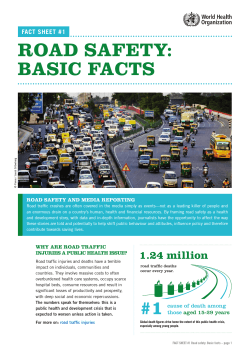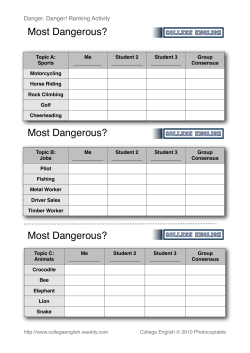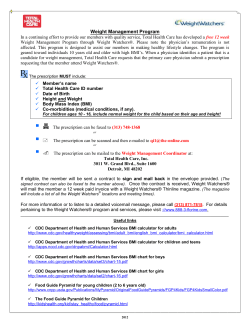
1 Child Child Injury
April 2012 1 Child Every hour, one child dies from an injury. Child Injury Child injuries* are preventable, yet more than 9,000 children died from injuries in the US in 2009. Car crashes, suffocation, drowning, poisoning, fires, and falls are some of the most common ways children are hurt or killed. The number of children dying from injury dropped nearly 30% 1 in 5 About 1 in 5 child deaths is due to injury. over the last decade. However, injury is still the #1 cause of death among children. More can be done to keep our children safe. * ‘Child injuries’ refers to unintentional injuries that occur among children and teens 0-19 years. To learn more about injury prevention See page 4 4 Seconds www http://www.cdc.gov/vitalsigns Every 4 seconds, a child is treated for an injury in an emergency department. National Center for Injury Prevention and Control Division of Unintentional Injury 1 Problem>> INJURY The #1 killer of children in the US 1 25 925 Many For every In 2005, injuries that resulted in death, hospitalization or an ER visit cost nearly $11.5 billion in medical expenses. child that dies there are... hospitalizations SOURCES: Web-based Injury Statistics Query and Reporting System (WISQARS), CDC, 2009. treated in ER National Health Interview Survey, 2009 data release, CDC, National Center for Health Statistics. more treated in doctors’ offices Global view The US child (0-14 years) injury death rate ranks among the worst of all high-income countries 11.1 The US child injury death rate is 4 times that of countries with the lowest rates. 2.4 2.0 SOURCE: Global Health Observatory Data Repository. Mortality and burden of disease: disease and injury country estimates, 2008, by sex and age. Sweden Netherlands 4.8 4.6 2.9 3.4 United Kingdom France Canada 6.0 Australia Poland 12.7 8.7 United States New Zealand Mexico Rate per 100,000 population State view Child (0-19 years) injury death rates vary by state WA AK MT ME ND MN OR ID VT SD HI WI WY MI IA NE NV IL MO NC TN AR SC MS TX VA KY OK NM CT RI NJ DE WV AZ 2 OH IN CO KS MA PA UT CA NH NY MD D.C. Rate per 100,000 population 4.0 – 10.9 11.0 – 17.9 GA 18.0 – 25.1 AL LA Not applicable FL In 2009, more than 5,700 children’s lives would have been saved if the lowest state death rate was achieved nationally. US rate is 11.0 SOURCE: Web-based Injury Statistics Query and Reporting System (WISQARS), CDC, 2009. Causes of child injury and prevention tips 4,564 Motor Vehicle Suffocation 1,160 Deaths Deaths 41% decrease 30% increase • Always use seat belts, child safety seats and booster seats that are correct for a child’s age and weight. • Make sure infants sleep alone; placed on their backs on a firm surface. • Use safe-driving agreements or contracts with teens. • Avoid loose bedding or soft toys in crib. • Be sure crib meets safety standards. Fall 151 Drowning Deaths Total Deaths 19% decrease 983 Deaths 28% decrease • Use a soft landing surface on playgrounds (such as sand or wood chips, not dirt or grass). • Learn to swim – important for parents and kids. • Use protective gear, like a helmet, during sports and recreation. • Use a four-sided fence with self-closing and self-latching gates around pool. • Install protective rails on bunk beds and loft beds. • Watch kids closely when they are in and around water. 391 Fire/burn Deaths 45% Poisoning 824 Deaths decrease 80% increase • Use smoke alarms – where people sleep and on every level of the home – and test monthly. • Create and practice a family fire escape plan. • Install a home fire sprinkler system if possible. • Keep medicines away from children and teens. • Keep cleaning solutions and other toxic products in original packaging and where children can’t get them. 3 Percentages show changes in death rates from 2000 to 2009. Deaths are from 2009. Total deaths include 1,070 from other causes. What Can Be Done States and communities can Employers can ◊◊Align efforts with the National Action Plan for Child Injury Prevention, released in 2012 by CDC and more than 60 partner organizations. Visit www.cdc.gov/safechild. ◊◊Protect all employees, including youth, from workplace injuries by complying with existing standards and regulations. ◊◊Strengthen data collection on child injury to identify problems and track progress. ◊◊Use strategies shown to reduce injuries such as graduated driver licenses, learn-to-swim programs, and prescription drug monitoring programs. ◊◊Improve access to poison control centers, trauma center care, and preventive services (such as CPR/first aid training). Health care systems can ◊◊Use technology, such as electronic medical records, to improve the speed and quality of care for injured children, and to monitor the number and severity of injuries. ◊◊Include child safety education for new parents and at all pediatric visits. ◊◊Provide proper safety training, education, and protective equipment for each job task. Everyone can ◊◊Take steps to prevent child injury where you live, work, and play. ◊◊Be a good role model—wear a seat belt, use a helmet, and follow other safety tips. ◊◊Learn more about protecting the ones you love at www.cdc.gov/safechild. For more information, please contact Telephone: 1-800-CDC-INFO (232-4636) TTY: 1-888-232-6348 E-mail: cdcinfo@cdc.gov Web: www.cdc.gov Centers for Disease Control and Prevention 1600 Clifton Road NE, Atlanta, GA 30333 Publication date: 4/16/2012 www http://www.cdc.gov/vitalsigns 4 CS230813-B
© Copyright 2025





















